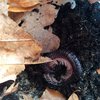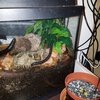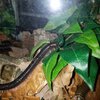MontePython
Arachnosquire
- Joined
- Feb 13, 2020
- Messages
- 96
Well, it finally happened to me - entirely my own fault, and I'm annoyed enough at myself for it, but here we are.
So Nero, my male D. macracanthus has been underground for the better part of a month and a half, so I assumed he was moulting.
As a result, whenever I've had to do anything with the enclosure, I've tried to be very careful not to do anything that might disturb him (usually I removed whoever was topside, but left anyone underground to it). This time was much the same - I scooped the other four into my 'holding pen' tub and went about trying to fix what needed fixing.
Long story short, I misjudged where he actually was, and accidentally uncovered him.
He's still very pale in colour (especially his legs) and doesn't seem capable of anything beyond what I'd call reflexive movement (shying from contact etc), and for a moment I thought he might be dead before I noticed the very slight movement.


I immediately worked to minimise contact and placed him in a small tub I'd originally set up to split off a small culture of the springtails in my tank for the smaller tank I'm setting up that already had a layer (about an inch and a half to two inches I think) of damp substrate, added some leaves to shelter him, and closed the lid (it has small hole vents at the very top for placing in the microwave - I'd added gauze earlier in the week to keep gnats or whatever from getting in and springtails from getting out).
It's currently placed near my tank so that it gets some heat from my space heater, (enough to not be very cold) but not enough to heat the substrate too much or dry it out (I do have a very small USB powered heat mat for emergencies but figured if they burrow, they probably need it to be cool).
The reason I opted not to leave him on the surface in the tank, because I'd heard somewhere that S. fischeri have a reputation for occasionally eating surface moulting tank mates (though that was mentioned mostly in reference to juveniles housed together, I didn't want to take any chances).
Basically, I guess I'm asking if there's anything else I can try to do to maximise his chances of surviving my clumsiness here. I know the odds are stacked against me, but if there's anything I can do (or anything I should watch for during this), the advice would be much appreciated.
So Nero, my male D. macracanthus has been underground for the better part of a month and a half, so I assumed he was moulting.
As a result, whenever I've had to do anything with the enclosure, I've tried to be very careful not to do anything that might disturb him (usually I removed whoever was topside, but left anyone underground to it). This time was much the same - I scooped the other four into my 'holding pen' tub and went about trying to fix what needed fixing.
Long story short, I misjudged where he actually was, and accidentally uncovered him.
He's still very pale in colour (especially his legs) and doesn't seem capable of anything beyond what I'd call reflexive movement (shying from contact etc), and for a moment I thought he might be dead before I noticed the very slight movement.


I immediately worked to minimise contact and placed him in a small tub I'd originally set up to split off a small culture of the springtails in my tank for the smaller tank I'm setting up that already had a layer (about an inch and a half to two inches I think) of damp substrate, added some leaves to shelter him, and closed the lid (it has small hole vents at the very top for placing in the microwave - I'd added gauze earlier in the week to keep gnats or whatever from getting in and springtails from getting out).
It's currently placed near my tank so that it gets some heat from my space heater, (enough to not be very cold) but not enough to heat the substrate too much or dry it out (I do have a very small USB powered heat mat for emergencies but figured if they burrow, they probably need it to be cool).
The reason I opted not to leave him on the surface in the tank, because I'd heard somewhere that S. fischeri have a reputation for occasionally eating surface moulting tank mates (though that was mentioned mostly in reference to juveniles housed together, I didn't want to take any chances).
Basically, I guess I'm asking if there's anything else I can try to do to maximise his chances of surviving my clumsiness here. I know the odds are stacked against me, but if there's anything I can do (or anything I should watch for during this), the advice would be much appreciated.



